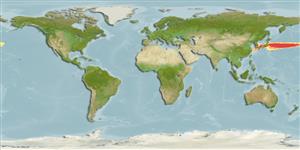Environment: milieu / climate zone / depth range / distribution range
Ekologi
laut batipelagis; kisaran kedalaman 0 - 950 m (Ref. 34506). Deep-water
Northwest Pacific.
Size / Weight / umur
Maturity: Lm ? range ? - ? cm
Max length : 5.6 cm TL jantan/; (Ref. 34506)
deskripsi pendek
Kunci identifiaksi (pengenalan) | Morfologi | Morfometrik
duri punggung lunak (Keseluruhan (total)) : 80; Sirip dubur lunak: 52. M. isaacsi differs from all other species of the genus by the following combination of characters: head long with elongate snout and almost straight jaw, skull length 7.0% TL, rostral fang strongly hooked with distal part in a nearly right angle to dorsal profile of skull, anterior dorsal fin ray above myomere number 13, jaw with 4 teeth, max depth of body 9.7% TL, and skin uniformly brown (Ref. 34506).
Life cycle and mating behavior
Maturities | Reproduksi, perkembang biakan | Spawnings | Egg(s) | Fecundities | Larva
Bertelsen, E. and J.G. Nielsen, 1987. The deep sea eel family Monognathidae (Pisces, Anguilliformes). Steenstrupia, 13(4):141-198. (Ref. 34506)
Status IUCN Red List (Ref. 130435)
ancaman kepada manusia
Harmless
penggunaan manusia
Alat, peralatan
laporan khas
muat turun XML
Sumber internet
Estimates based on models
Preferred temperature (Ref.
123201): 0.8 - 16.4, mean 9.7 °C (based on 41 cells).
Phylogenetic diversity index (Ref.
82804): PD
50 = 0.5001 [Uniqueness, from 0.5 = low to 2.0 = high].
Bayesian length-weight: a=0.00102 (0.00046 - 0.00225), b=3.06 (2.88 - 3.24), in cm total length, based on all LWR estimates for this body shape (Ref.
93245).
Trophic level (Ref.
69278): 3.2 ±0.5 se; based on size and trophs of closest relatives
Fishing Vulnerability (Ref.
59153): Low vulnerability (10 of 100).
